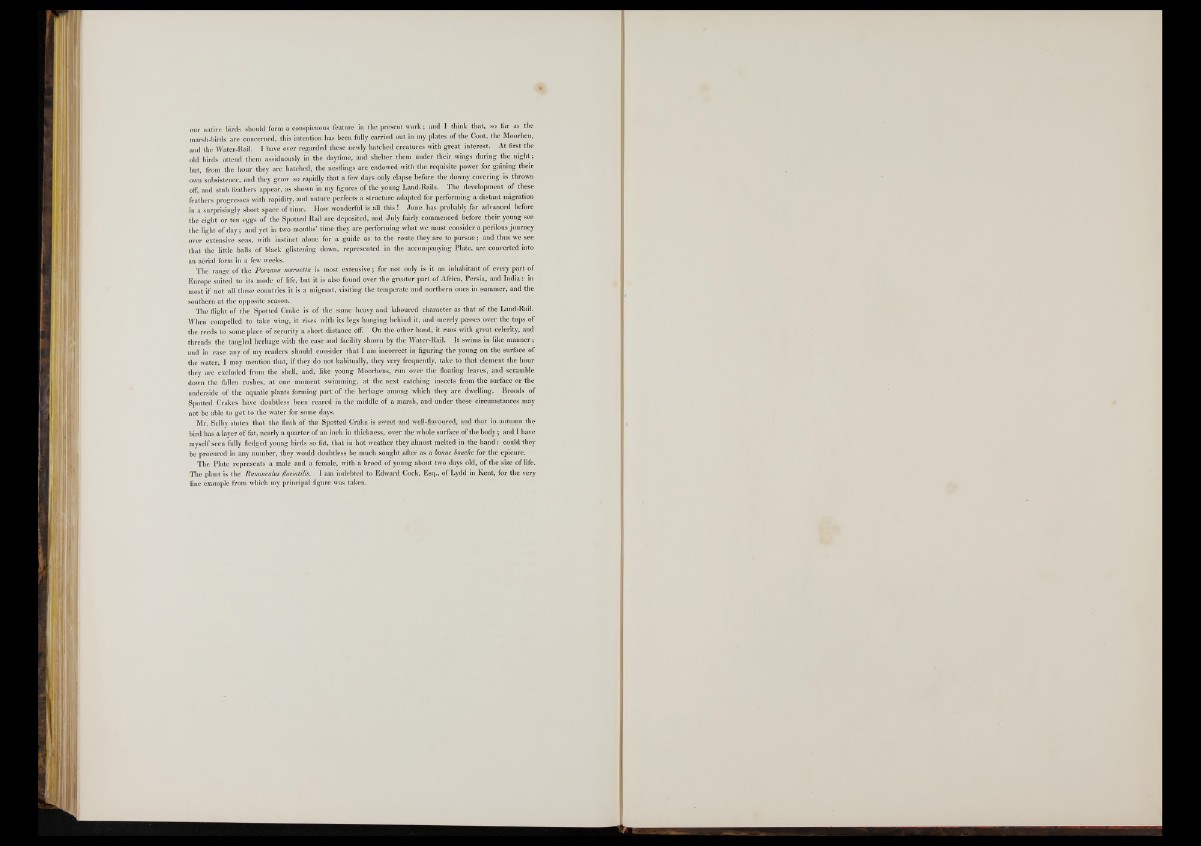
our native birds should form a conspicuous feature in the present work; and I think that, so far as the
marsh-hirds are concerned, this intention has been fully carried out in my plates of the Coot, the Moorhen,
and the Water-Rail. I have ever regarded these newly hatched creatures with great interest. At first the
old birds attend them assiduously in the daytime, and shelter them under their wings during the night |
but, from the hour they are hatched, the nestlings are endowed with the requisite power for gaining their
own subsistence, and they grow so rapidly that a few days only elapse before the downy covering is thrown
off, and stub feathers appear, as shown in my figures of the young Land-Rails. The development of these
feathers progresses with rapidity, and nature perfects a structure adapted for performing a distant migration
in a surprisingly short space of time. How wonderful is all this ! June has probably far advanced before
the eight or ten eggs of the Spotted Rail are deposited, and July fairly commenced before their young see
the light of day; and yet in two months’ time they are performing what we must consider a perilous journey
over extensive seas, with instinct alone for a guide as to the route they are to p u rsu e ; and thus we see
that the little balls of black glistening down, represented in the accompanying Plate, are converted into
an aerial form in a few weeks.
The range of the Porzana maruetta is most extensive; for not only is it an inhabitant of every part of
Europe suited to its mode of life, but it is also found over the greater part o f Africa, Persia, and In d ia : in
most if not all these countries it is a migrant, visiting the temperate and northern ones in summer, and the
southern at the opposite season.
The flight of the Spotted Crake is o f the same heavy and laboured character as that of the Land-Rail.
When compelled to take wing, it rises with its legs hanging behind it, and merely passes over the tops of
the reeds to some place of security a short distance off. On the other hand, it runs with great celerity, and
threads the tangled herbage with the ease and facility shown by the Water-Rail. It swims in like manner;
and in case any of my readers should consider that I am incorrect in figuring the young on the surface of
the water, I may mention that, if they do not habitually, they very frequently, take to th at element the hour
they are excluded from the shell, and, like young Moorhens, run over the floating leaves, and scramble
down the fallen rushes, at one moment swimming, at the next catching insects from the surface or the
underside o f the aquatic plants forming part o f the herbage among which they are dwelling. Broods of
Spotted Crakes have doubtless been reared in the middle of a marsh, and under these circumstances may
not be able to get to the water for some days.
Mr. Selby states that the flesh of the Spotted Crake is sweet and well-flavoured, and that in autumn the
bird has a layer o f fat, nearly a quarter o f an inch in thickness, over the whole surface o f the body; and I have
myself seen fully fledged young birds so fat, that in hot weather they almost melted in the h a n d : could they
be procured in any number, they would doubtless be much sought after as a bonne bouche for the epicure.
The Plate represents a male and a female, with a brood of young about two days old, o f the size o f life.
The plant is the Ranunculusflwoiatilis. I am indebted to Edward Cock, Esq., of Lydd in Kent, for the very
fine example from which my principal figure was taken.